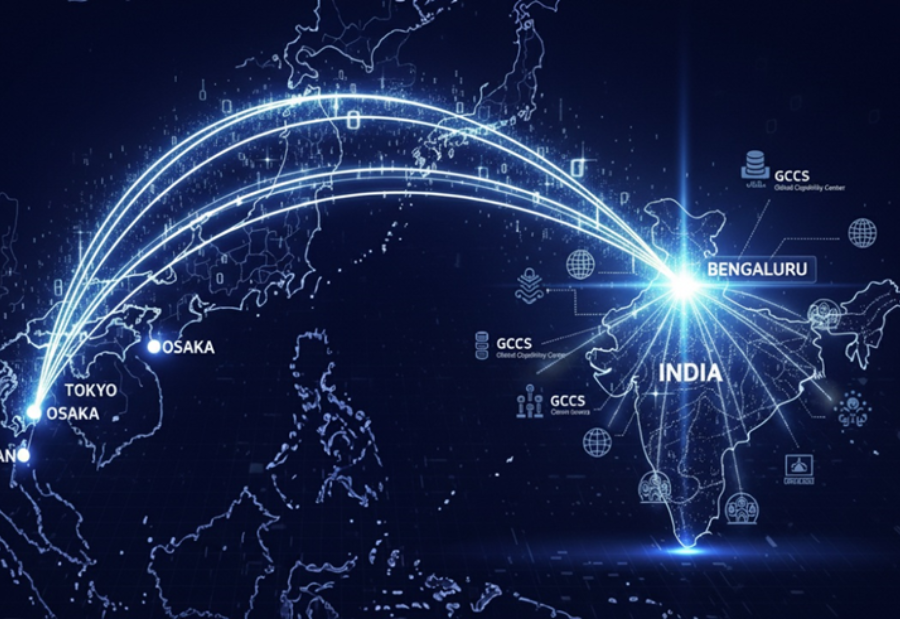For years, the story of Global Capability Centres (GCCs) in India has been dominated by American and European multinationals. The narrative was familiar — cost optimisation, offshore tech support, talent at scale. But lately, I’ve noticed a different kind of momentum building. One that’s more understated, more deliberate and unmistakably Japanese.
In my view, this is one of the most significant but under-discussed shifts happening in the global enterprise landscape. Japanese firms, known for their precision, patience, and methodical planning, are increasingly establishing GCCs in India. And they’re not doing it for short-term advantage. They’re doing it because they have to — and because India is uniquely positioned to deliver what they need.
A Structural Challenge at Home
What’s driving this shift? One word: demographics.
Japan is facing a demographic decline like few other economies. With nearly 30% of its population over the age of 65 and an expected loss of over 11 million workers by 2040, the talent crisis isn’t looming — it’s already here. Add to that a corporate tech stack where over 60% of mission-critical systems will be more than 20 years old by the end of 2025, and the urgency becomes clear.
Japanese companies can no longer rely on homegrown resources to sustain, let alone transform, their businesses. That reality has forced a strategic pivot — one that places India at the center.
India: No Longer Just a Back Office
What I find particularly striking is that Japanese firms aren’t simply looking at India as a support destination. They’re betting on it as an engine for innovation, growth, and long-term capability.
Take Rakuten, for instance. Its Bengaluru center isn’t just supporting operations, it’s developing 5G, AI, and next-gen software platforms. Dai-ichi Life has set up a digital hub in Hyderabad that’s now central to its insurance transformation initiatives. Toyo Engineering, through its OFS India venture, is handling procurement and engineering work that is critical to its global oil and gas projects. Hitachi continues to expand its presence here across digital, energy, and sustainability domains.
These are not tactical plays. They are structural investments.
What Makes India So Attractive?
From what I’ve seen and experienced, there are a few key reasons Japan is looking at India more seriously than ever before:
- Talent depth and digital maturity: India has more than 5 million tech professionals, and a growing number of them are working in deep tech, AI, cybersecurity, and cloud.
- Cost-to-skill advantage: While cost remains a factor, it’s the blend of affordability and skill depth that makes Indian GCCs uniquely competitive.
- Ecosystem readiness: The Indian GCC ecosystem is more mature today, from policy support to talent availability to infrastructure. And that matters, especially to companies like those in Japan that value stability and predictability.
That said, the approach is very much in keeping with Japanese corporate culture: cautious, methodical, and deeply strategic. Many firms prefer the Build-Operate-Transfer (BOT) model before taking full ownership. They’re not rushing in — but they are committing for the long haul.
The Cultural Bridge
Of course, it’s not all smooth sailing.
The cultural alignment between Japanese HQs and Indian teams is a real challenge. I’ve seen this firsthand what’s considered respectful, urgent, or efficient can vary dramatically across the two cultures. But what I also see is growing maturity on both sides.
Companies are investing in cross-cultural training, hiring bilingual leaders, and building hybrid management models. And in my view, the firms that do this well will be the ones that truly unlock the full value of their India investments.
Why This Matters?
For India, the rise of Japanese GCCs is more than just another foreign investment story. It represents a deeper kind of trust, one that’s built on capability, not just cost.
For Japan, this is a necessary recalibration. As domestic constraints tighten, India is becoming a critical part of the solution. This is about building continuity, resilience, and future-ready operations in a world where disruption is now the norm.
Japanese companies are not known for moving quickly — but they are known for moving with intent. And in choosing India as a key part of their long-term strategy, they are sending a clear signal: the future of Japanese enterprise will be global, and India will be at the center of it.
This is not about outsourcing. It’s about reshaping how global businesses are built and run. And if we pay attention, we’ll realize this quiet transformation could have a lasting impact on how Asia collaborates, innovates, and grows together!
Also read: Viksit Workforce for a Viksit Bharat
Do Follow: The Mainstream formerly known as CIO News LinkedIn Account | The Mainstream formerly known as CIO News Facebook | The Mainstream formerly known as CIO News Youtube | The Mainstream formerly known as CIO News Twitter |The Mainstream formerly known as CIO News Whatsapp Channel | The Mainstream formerly known as CIO News Instagram
About us:
The Mainstream formerly known as CIO News is a premier platform dedicated to delivering latest news, updates, and insights from the tech industry. With its strong foundation of intellectual property and thought leadership, the platform is well-positioned to stay ahead of the curve and lead conversations about how technology shapes our world. From its early days as CIO News to its rebranding as The Mainstream on November 28, 2024, it has been expanding its global reach, targeting key markets in the Middle East & Africa, ASEAN, the USA, and the UK. The Mainstream is a vision to put technology at the center of every conversation, inspiring professionals and organizations to embrace the future of tech.




